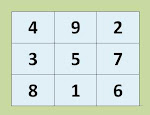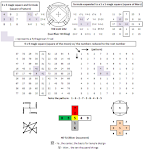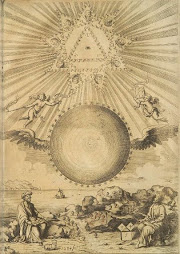The symbolic meaning of the distinctive geometrical and
mathematical design will lead us to the understanding of the use of the
quincunx, or geometric patterns of mystical mathematical symbolism based on the
Chinese magic square and used famously in Christian art and architecture of the
Middle Ages (and now thanks to this discovery, used in early Roman times as
well). But first, before we dive into
the mathematical model for time and space, let’s go over a little background,
or provenance, of this mosaic from Caligula’s ship.
Caligula was a famous Roman emperor who reigned from A.D.
37-41. His decadent tastes led him to
build giant ships, not for travel, but for entertainment and retreat from
reality. These ships were anchored on
Lake Nemi – a circular volcanic lake outside Rome. Following Caligula’s assassination, the ships
were sunk. Mussolini, between 1929 and 1932, had the lake drained and the ships
hauled ashore. This mosaic was discovered
and placed in a museum especially built for the artifacts recovered in two of
Caligula’s ships in 1936. By the end of
World War II, the museum was burned down and many of the artifacts were damaged or
destroyed but this mosaic survived undamaged leading some to speculate that the
mosaic was removed before the destruction of the museum.
In a rare sighting of the stolen artifact, the mosaic was
spotted in a gallery in Rome and was photographed in the 1960s. In 2013, an Italian expert on ancient
marbles, Dario Del Bufalo, was lecturing a group of art historians and dealers in
New York and displayed the photo. The mosaic
was recognized by some of the people at the lecture as being on display at the
home of Mr. and Mrs. Fioratti of New York.
Evidently, an Italian aristocratic family who possessed the mosaic sold
the piece to the Fiorattis in the late 1960’s thru a broker, an Italian police
official known for recovering looted art by the Nazis.
The Manhattan District Attorney’s Office had a judge issue a
warrant to seize the mosaic on September 18, 2017 on the basis that the
authorities have evidence that the piece was stolen from an Italian museum
before World War II. The mosaic was
returned to the Italian government October 19, 2017. Mrs. Fioratti offered no
resistance.
The Caligula mosaic demonstrates the typical design used by
the early church in art and architecture during the Middle Ages. The cross-in-square represents the four
cardinal directions and intersects in the center, or axis mundi, where Heaven, earth, and humankind co-exist. The cross-in-square pattern creates the four
quadrants where we can see four circular figures. The cross-in-square represents Heaven and the
four circles represent earth. This is
typical of quincunx geometry, or four objects arranged around a central
object. However, the relevance is
mystical mathematical symbolism which incorporates Heaven, earth, the center or
axis mundi, and humankind. In addition, when we consider the Chinese
magic square, we also incorporate the concepts of math, the right-angle
triangle theorem (or Pythagorean Theorem) and the numbers of the calendar.
As described many times before in this blog and in my book Number Time Archetype, there exists a
formula to apply to the Chinese magic square that will lead to a set of magic
squares called “magic squares in the Luo Shu format”. These magic squares reveal a Pythagorean
triplet of numbers at the heart of each square – a reference to the Pythagorean
Theorem – which represents the describing of space in mathematical terms. In addition, these magic squares will always
have a cross of odd numbers thru the vertical and horizontal axis which creates
the four quadrants. Upon closer
examination of the mosaic, one can see within the cross-in-square pattern a
grid and within this grid exists a second quincuncial arrangement of four
gnomon shapes or right angles around an identifiable center, a clear reference
to the gnomon, a keeper of time, and the right angle or carpenter’s square, a
symbol of time and space. And the number
365, the number associated with the solar cycle, appears at the center of the
27x27 magic square, which represents time.
These squares, a gift from Heaven, had special reverence to the ancient
Chinese a thousand years prior to their adoption by the Romans and Christians.
Therefore, the symbolic meaning of the quincunx incorporates
all these concepts: Heaven, earth, humankind, the axis mundi, the four cardinal directions as well as time and
space. This is why the quincunx geometry
was used as the ground plan for church design during the Middle Ages (known as
the quincunx or cross-in-square ground plan) and why this same geometry appears
on several covers of illuminated manuscripts during the Carolingian period, as
well as on church art such as altar cloths and tapestries.
However, the provenance of the magic square is Chinese and
is known as the Luo Shu. The Chinese
used the magic square as their template for temple design as well as for city
layouts and royal tomb design (see Alfred Schinz, The Magic Square: Cities in Ancient China and Lars Berglund, The Secret of the Luo Shu: Numerology in
Chinese Art and Architecture).
The Quincunx as a Cosmic Symbol
Paloma Pajares-Ayuela sums it up best in her book, Cosmatesque Ornament:
The
center symbolizes the beginning, the origin, the starting point, the pure
being, the absolute, the transcendent; in three dimensions, the center
corresponds to the axis, which unites a point with the zenith (the North
Star), indicating verticality. The circle–in space, the sphere–represents
the infinite, transcendent, and complete, in sum, the divine, God. The square–in space, the cube–is the symbol of the material, of the finite, non-transcendent,
limited, solid; it is the symbol of the earth, connected in its order to the
four cardinal points. The cross marks
the four points of the compass; it stems from joining the center with each one
of the points, establishing the orientation of the point in space and in time
(solstices and equinoxes; change of seasons). The cross is the mediating symbol that
connects heaven and earth.








